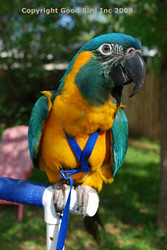Parrot Training In New Environments
Posted by New environments, Parrot training, bird training on 26/1/2024
Barbara Heidenreich explains how to train your Parrot in new environments.
If you are a Parrot training fan, you have probably already trained your bird to do a few cute things like maybe wave or turn around on cue. Have you ever tried to ask your Parrot to present those behaviours in a new environment?
Such as a bird club meeting or at a friend’s house or maybe the veterinary hospital. For some Parrots this can be very challenging. Suddenly your outgoing social butterfly freezes up and seems to have forgotten all the things you have taught him to do.

In truth he probably hasn’t forgotten, he is just not yet learned to present behaviours in other environments. The process of teaching an animal to present a behaviour under many different conditions is called generalization.
Beni
Beni, the Blue-throated Macaw has done so well with harness training it was time to let him experience some new environments while wearing his spiffy blue harness. First we visited different rooms in my house. The bathroom was particularly fun. He got quite excited by his reflection in the mirror. I think he even tried to say “hello” in Macaw language.
He did well in each of the rooms of the house. They weren’t much different from what he was used to. He would take treats, and fly to me and other perches on cue. However when we ventured into the back yard, it was a different story. This environment was quite unusual for him. So we took it slow. For the first few days I kept the sessions short and gradually walked him to more areas of the yard. He accepted a few head scratches and treats after some initial looking around, but did not look quite as relaxed as I wanted.
Finally today he started to seem a bit more comfy. I thought now would be a good time to try a favourite strategy of mine. One great way to help a bird move onto the next steps toward generalization is to cue a super simple behaviour over and over a few times.

Body language
This gives the bird something to focus on that he knows earns some positive reinforcers. What Beni does best is fly to me. I grabbed a familiar perch and placed it in the yard. With the leash safely wrapped around my wrist, Beni recalled like a champ. Next thing you know his body language looked much more relaxed and he began to show an interest in exploring this new world with confidence.
For Beni, recall is an easy behaviour. For your Parrot it might be something like saying “hello” or lifting his wings or foot when cued. Any behaviour your Parrot offers readily is ideal for this strategy. Your bird may need some time to desensitize to the environment first before he will present behaviour, just like Beni did. But after just a few sessions of looking around, Beni was ready.
Once Beni has a few more days of relaxed body language in the back yard, it will be onto another new location and a repeat of the process. Eventually Beni will learn that presenting behaviours in any environment is easy and earns you favourite things like head scratches and treats.

 African Grey
African Grey
 Amazon
Amazon
 Budgie
Budgie
 Caique
Caique
 Canary and Finch
Canary and Finch
 Cockatiel
Cockatiel
 Cockatoo
Cockatoo
 Conure - Large
Conure - Large
 Conure - Small
Conure - Small
 Eclectus
Eclectus
 Lovebird
Lovebird
 Macaw - Large
Macaw - Large
 Macaw - Small
Macaw - Small
 Meyer's and Senegal
Meyer's and Senegal
 Quaker
Quaker
 Kakariki
Kakariki
 Alexandrine
Alexandrine
 Avian Specific
Avian Specific
 Bird Systems
Bird Systems
 Manzanita
Manzanita
 Marriages
Marriages
 Mikey and Mia
Mikey and Mia
 Planet Pleasures
Planet Pleasures
 Psittacus
Psittacus
 Your Parrot
Your Parrot
 Arcadia Bird Lights
Arcadia Bird Lights
 Assorted Brands
Assorted Brands
 Aviator Harnesses
Aviator Harnesses
 Beaphar Bogena
Beaphar Bogena
 Bird Kabobs
Bird Kabobs
 Bird Street Bistro
Bird Street Bistro
 Birdie Bangles
Birdie Bangles
 Brown's
Brown's
 Bucktons
Bucktons
 Busy Bird
Busy Bird
 Jelly Cups
Jelly Cups
 Creative Foraging
Creative Foraging
 F10 Disinfectant
F10 Disinfectant
 Hari
Hari
 Harrison's
Harrison's
 Java
Java
 Johnsons
Johnsons
 Johnston and Jeff
Johnston and Jeff
 Kaytee Exact
Kaytee Exact
 King's
King's
 Lafeber NutriBerries
Lafeber NutriBerries
 Liberta 2nd Edition Parrot Cages
Liberta 2nd Edition Parrot Cages
 Liberta Cages
Liberta Cages
 Natures Instinct
Natures Instinct
 Northern Parrots
Northern Parrots
 Paradise Toys & Accessories
Paradise Toys & Accessories
 Parrot Cafe
Parrot Cafe
 Parrot Safe Candles
Parrot Safe Candles
 Polly's Natural
Polly's Natural
 Poop-Off
Poop-Off
 Pretty Bird
Pretty Bird
 Prevue Hendryx
Prevue Hendryx
 Rainforest Cages
Rainforest Cages
 Super Bird Creations
Super Bird Creations
 The Birdcare Company
The Birdcare Company
 TOP'S Parrot Food
TOP'S Parrot Food
 Versele-Laga
Versele-Laga
 Vetark
Vetark
 Vitakraft
Vitakraft
 Vitapol
Vitapol
 Xtra Vital
Xtra Vital
 Zoo-Max
Zoo-Max
 ZooMed
ZooMed
 ZuPreem
ZuPreem
